The 13 Best Animated Star Wars Moments
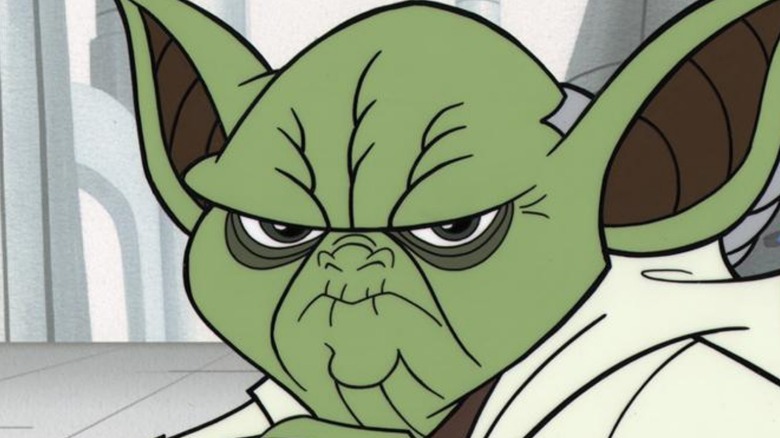
Genndy Tartakovsky's hand-drawn "Star Wars: Clone Wars" series, which aired from 2003 to 2005, did not mark Star Wars' first foray into animation. Such can be traced back to 1985, shortly after "Return of the Jedi." But the micro-series heralded the arrival of a new era for animated storytelling that seriously expanded the canon of the galaxy far, far away. While Tartakovsky's contributions are archived as proto-canon, slotted in the same "Star Wars Vintage" section of Disney+ as 1985's "Ewoks" and "Droids" animated series, his shorts provided the blueprints that the rest of the franchise built off of for both animated and live-action projects alike.
Before the live-action show "The Mandalorian" debuted, Star Wars' animated series comprised an extensive effort to introduce and spotlight a multiplicity of familiar faces (Anakin Skywalker, Obi-Wan Kenobi, Yoda), new players (Hello, Ahsoka Tano and clones), and never-before-seen takes on the Force. In celebration of the latest animated Star Wars project, the anime anthology "Star Wars: Visions," we've assembled a list of the best scenes from both the 2D "Clone Wars" and the 3D-animated projects that followed. Sit back and enjoy some of the very best moments that Star Wars has to offer.
Darksaber History 101 — Star Wars Rebels
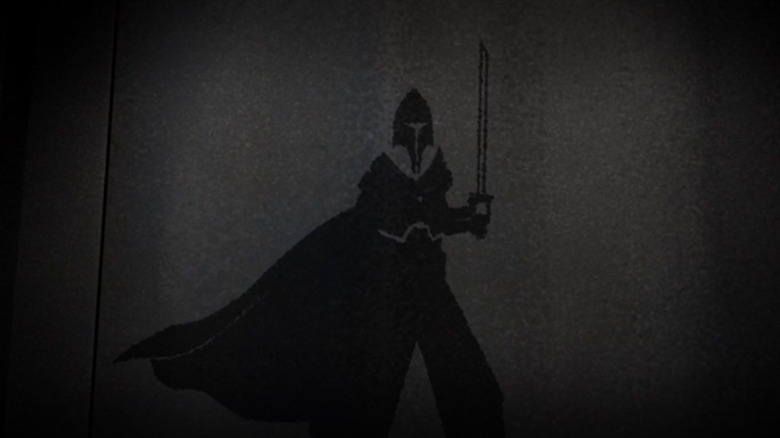
In "Trials of the Darksaber," a Season 3 episode of "Star Wars: Rebels," Jedi Kanan Jarrus places the black-bladed Darksaber into the hands of a Mandalorian and asks some big questions. His actions activate a 2D sequence that breathes life into an old legend, and offers up some much-needed exposition. When the Mandalorian Fenn Rau flicks on the Darksaber, shadowy figures reveal the history of the Mandalorian lightsaber.
The sequence only lasts for about 20 seconds, but it's full of information. The Darksaber was forged and wielded by Tarre Vizla, the first Mandalorian Jedi. Through seamless animated transitions, Tarre Vizla's passing is signified by his body merging with the Jedi Temple itself, as the Darksaber becomes one of the Temple's spires. Then, the Mandalorian warriors "liberate" the Darksaber (Fenn Rau's word choice says a lot), much like King Arthur pulling the sword from the stone. A relic's meaning is redefined through its shifting ownership.
The Darksaber's dual heritage, both Jedi and Mandalorian, resonates throughout "Trials of the Darksaber," reinforcing the simmering tensions -- and the personal bonds -- between the Mandalorians and the Jedi. Now, those same tensions have crept into relationship between Kanan and his Mandalorian protégé, Sabine Wren. During their training sessions, Kanan's Jedi background and Sabine's Mandalorian upbringing clash, playing out as both a psychological battle and a lightsaber duel.
Sabine Wields The Darksaber — Star Wars Rebels
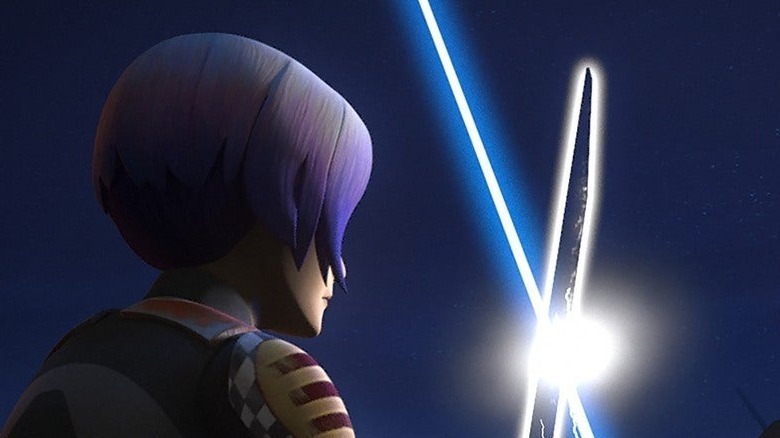
"Trials of the Darksaber" tells an enriching story over its 22-minute runtime. Young Mandalorian Sabine Wren trains hard to wield the Darksaber, the lightsaber that denotes the ruler of Mandalore. Having never trained someone who's not Force-sensitive, Kanan Jarrus must decide if it's right to let Sabine to handle the Darksaber. It's a heavy burden to shoulder. The rest of Sabine's found family, particularly Hera, isn't comfortable pushing the weight of leadership on Sabine.
After some heated training, Kanan Jarrus allows Sabine to wield the Darksaber. As Sabine holds the item of that represents her dual heritage -- she's Mandalorian, but also Kanan's surrogate child -- their fight doubles as an extreme therapy situation. Sabine tearfully reveals her backstory: her role building weapons for the Empire, the deadly use of Sabine's creation on her own home world, her defection, and her abandonment by her clan. It's psychological drama mixed with lightsaber swiping, and Sabine's cathartic confessions strengthen her bonds with Kanan and Ezra.
A lesser series would pressure the young heroine into a accepting a restrictive destiny and responsibility. But the most important thing that happens to Sabine is when her found family performers a customary Mandalorian bow, respecting Sabine's right to either accept or lay down her burden on her own terms.
The Farm Boy Sees Mace Windu Decimate Droids — Star Wars: Clone Wars
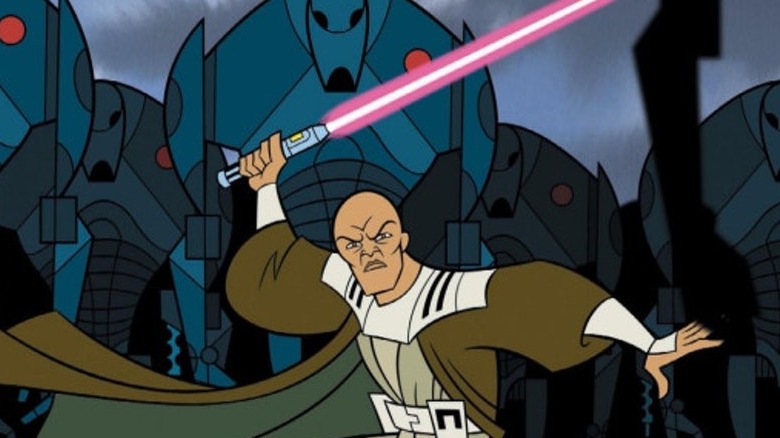
More concerned with the experience than the story, which is told through mostly self-contained shorts, the hand-drawn "Star Wars: Clone Wars" series was full of highly-choreographed, show-stopping action setpieces, one of which involves our favorite purple-lightsaber wielding Jedi, Mace Windu.
It's a dream seeing the legend in action, one that a farm boy experiences first hand when he spies Mace Windu from a nearby cliff. When a thousand-droid army knocks Mace Windu's lightsaber away, how does the Jedi survive without his weapon? How about by Force-shoving and speed-punching the droids with bare knuckles? The visual composition is astounding, from the titanic machines punching the ground to create craters to the mounds of droids encircling the lone Jedi, holding him at gunpoint. There's one impeccable sight gag in which Windu uses the Force to remove the nuts and bolts from a battle droid with such precision that its breakdown doesn't register immediately.
Mace's dialogue-free break to greet the star-struck boy is heartwarming -- it's like watching a child meet Superman, and taps in to the Jedi's humanity. The child lets Mace take a long gulp from his canteen -- even Jedi must hydrate! -- and then Windu zips back into the battlefield. In return, the Master gives the child a story to tell. We hope he survived the war, and was able to pass his tale on to the next generation.
Ahsoka Versus Darth Vader — Star Wars Rebels
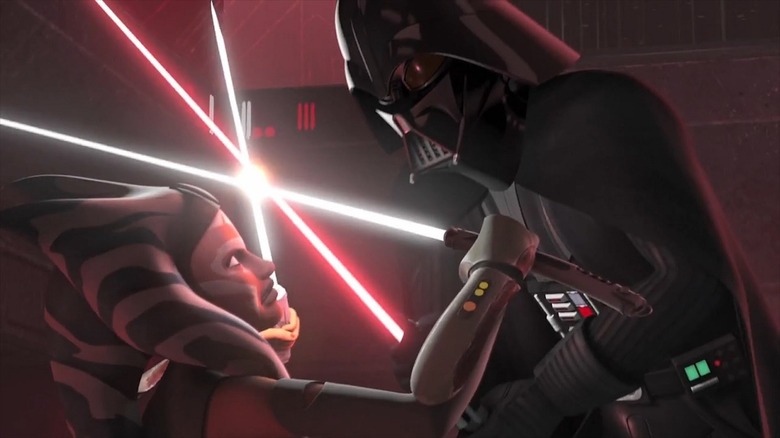
"Twilight of the Apprentice," the Season 2 finale of "Star Wars Rebels," gave us the long-anticipated showdown between Ahsoka and her former master, Anakin Skywalker, now transformed into Darth Vader. Their reunion hits like a ton of flying debris. Ahsoka proclaims that she wants to avenge her master. In response, Vader mocks Ahsoka, who left the Jedi Temple as a padawan, for abandoning the Jedi way. Cue Ahsoka's Eowyn-esque one-liner, "I am no Jedi," showing that she's grown beyond her Jedi upbringing. They engage in a duel to the death -- or, in this case, a cruel limbo for both master and apprentice.
But the heartbreaking moment comes with the fissure in Vader's helmet, which allows Ahsoka to see the face of her teacher one last time. Triggering her guilt over leaving Anakin, the sight motivates Ahsoka to stay with him, for better or for worse.
We know that Ahsoka can't defeat Darth Vader, and even if it's later revealed that she escaped, we worry about her future. It would be simple to write off Ahsoka's uncertain fate as a cheap cliffhanger, but the ambiguity acquires a visual poetry. Ahsoka's disappearance on Malachor is a riddle. It's as if Ahsoka knows that she'll return, but has to let herself be swallowed by darkness in order to rise someplace else. Fans rejoiced when Ahsoka appeared later on "Rebels" and "The Mandalorian," but this could've easily been the end of Ahsoka's story -- watching her fade into a piece of cryptic, half-forgotten lore is a fitting conclusion for the character.
The Blinding Of Kanan Jarrus — Star Wars Rebels
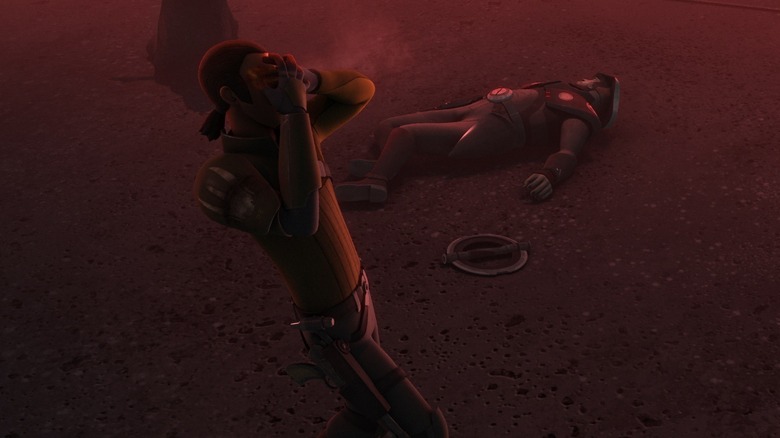
In "Twilight of the Apprentice," Maul, the villain who, like a cockroach, seems to survive everything, blinds Kanan Jarrus on Malachor. While crawling for his saber, Kanan puts on a dusty Jedi Temple mask to symbolically affirm that he will continue his duties as a protector. Kanan's survival hinges on his faith in the Force, as well as listening closely to Maul's clanking steps. He manages to fling the former Sith down the Temple, and lives another day. The showdown is one of Kanan Jarrus' best moments, as he refuses to back down even after losing one of his main abilities.
This permanent injury shifted the status quo for the crew of the Ghost and for "Star Wars Rebels" as a whole. While Kanan would adapt, his blinding had major emotional ramifications; for example, Kanan's apprentice, Ezra, is wracked with guilt, while Kanan himself can no longer see the woman that he loves.
Accepting Kanan's Death — Star Wars Rebels
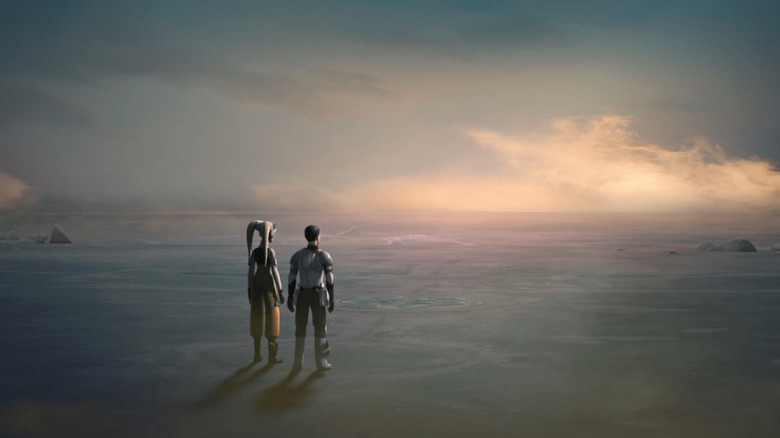
When Kanan Jarrus sacrifices himself in the episode "Jedi Night" to ensure the survival of his friends, his apprentice Ezra Bridger, his lover Hera Syndulla, and the rest of his crew mourn for him. A few episodes later, in "World Beyond Worlds," Ezra Bridger makes a discovery that irrevocably changed Star Wars canon: a cosmic plane full of portals that reach across time. Ezra spies a portal that he might be able to use to reverse Kanan's death, but is talked out of it in order to preserve the timeline (also, it's a trap set by Darth Sidious). Ezra leaves the temple and hears Kanan's spirit: "Remember, the Force will always be with you."
For an episode that's a brash and bold reinvention of Star Wars lore, the foggy conclusion contains poignant emotional undercurrents. Reunited with Hera, Ezra hears her say, "Kanan's gone, isn't he? I mean, really gone." This sounds like an extra beat in Hera's mourning, but it reveals a devastating truth: Hera and Ezra have finally let Kanan go. Mist overtakes the valley and the field. To the mournful rumbling of Kevin Kiner's score, a Lothwolf vanishes into the haze, symbolizing Kanan's spirit passing on. The fog encapsulates both the elegance and the haze of grief.
The Colossus Cheers Kaz — Star Wars Resistance
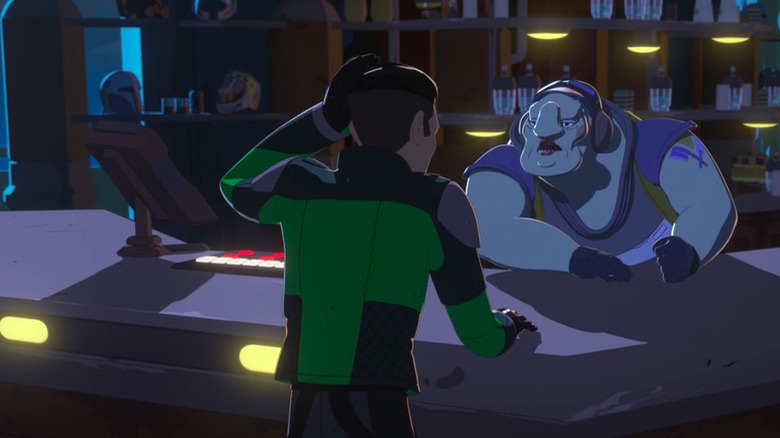
"Star Wars Resistance," a series set just before the sequel trilogy that adopts a bright, cel-shaded aesthetic, is an underrated gem that emphasizes the power of community and the regular people in the Star Wars universe. It is set aboard the Colossus, a former Imperial fueling station that's been converted into a civilian area where merchants, racers, thugs, mechanics, and a matronly bartender all reside. Whereas "The Clone Wars" and "Rebels" hopped from planet to planet, the cast of "Resistance" is anchored to one giant-sized location in Season 1 -- said location heads off into the stars to escape the First Order in Season 2.
"The High Tower" arguably marks the moment when "Resistance" matured into a project that's distinct from "The Clone Wars" and "Rebels." Kazuda Xiono, an unlucky Resistance spy moonlighting as a mechanic, gets into a pickle that leads to him sneaking around the thin exterior ledges of the Colossus' High Tower. One slip up and Kaz could plummet into the sea. Humorously, Kaz's co-workers and the Colossus' bar patrons can see his escapades through the window. What happens is both comical and revealing. Being ruffians who thrive on gambling, the crowd bets on whether Kaz will survive or die. Every time that Kaz successfully leaps over ledges, the spectators cheer.
This episode may not sound like much, but these crowd shots cement the "everyone knows everyone" intimacy among the residents of the Colossus. Yes, it's not particularly humane to laugh at another's misfortune, but community is important to "Star Wars Resistance," and "The High Tower" proves it.
The Bombardment Of The Clones' Home — Star Wars: The Bad Batch
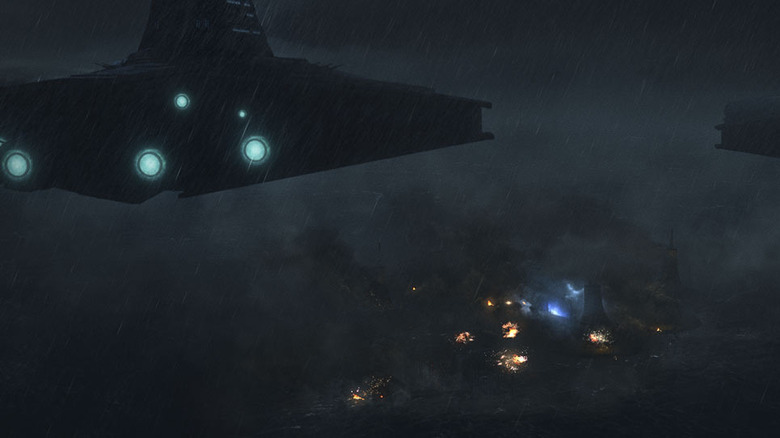
Clones never had it great. They were grown in vats, they endured accelerated aging that forced them into adulthood, they trained, and then they were shipped off to fight for the Republic. As demonstrated throughout "The Clone Wars," the clone troopers have no life outside of the war, and its sequel series, "The Bad Batch," delves into how their relevance wanes once the Clone Wars are over and the Empire reigns supreme.
In a series of cuts, the "Bad Batch" Season 1 finale "Kamino Lost" uses an ambitious editing technique unlike anything else seen in Lucasfilm's CGI productions: a quick montage consisting of empty locations on Kamino, including unoccupied chambers, vacant cafeteria tables, and the quarters of Clone Force 99. The shots drum home the stakes and stir a flood of emotions before an orbital bombardment destroys Tipoca city.
The emotional impact is a double-edged sword, both a mourning and a reckoning. On the one hand, the clone soldiers lose their home; it's an unceremonious farewell to the relative stability of an old era. But the old days were not good old days. Those shots also reckon with the unsettling fact that the clones weren't created for anything other than a short-lived, battlefield-conditioned existence. On Kamino, lives were engineered for warfare, and nothing more. Cranky clone Crosshair resented it. Young Omega felt trapped there. And now it's gone, all of the clones' memories sinking away with the structure.
Ahsoka And Maul In The Throne Room — Star Wars: The Clone Wars
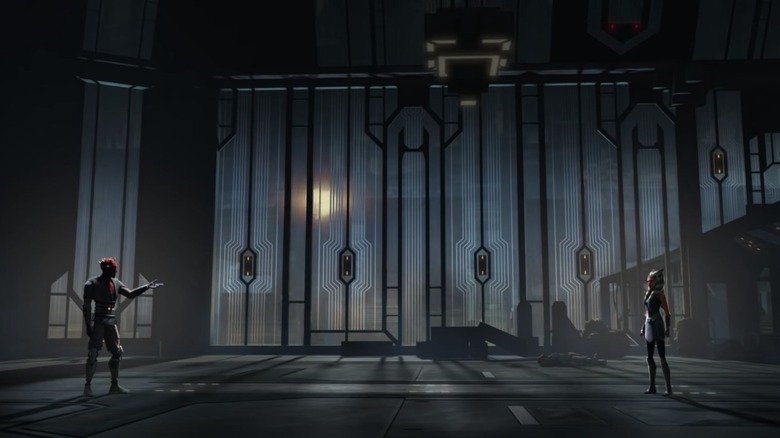
Knowing too much is a burden. It doomed Anakin Skywalker, and Maul understands its weight as well. His desperation amplifies in "The Phantom Apprentice," when Ahsoka confronts him in the Mandalorian throne room. There, Maul divulges that her master will become the Sith's apprentice, and offers to make an alliance to fight the greater evil. By this time, both Ahsoka and Maul have been abandoned, and have grown beyond their respective Jedi and Sith upbringings; there's an unspoken aura of mutual understanding between the two, despite their opposition.
The more they stay in that space, the more that Maul and Ahsoka realize that they are small players in the overall galactic struggle, and their inner turmoil manifests as a war storm. The storm shatters the windows, but Ahsoka and Maul stand still, letting the shards pass through as if they're letting in the unknown. The standstill highlights how far they are from the major historical events unfolding -- mainly, Anakin's fall to the dark side and the beginning of Palpatine's reign -- despite being tangled up in the larger story. A long-hyped fight scene, for which Ray Park and Lauren Mary Kim performed motion capture as Maul and Ahsoka, respectively, breaks out between them.
The Colossus Crew Grab Drinks — Star Wars Resistance
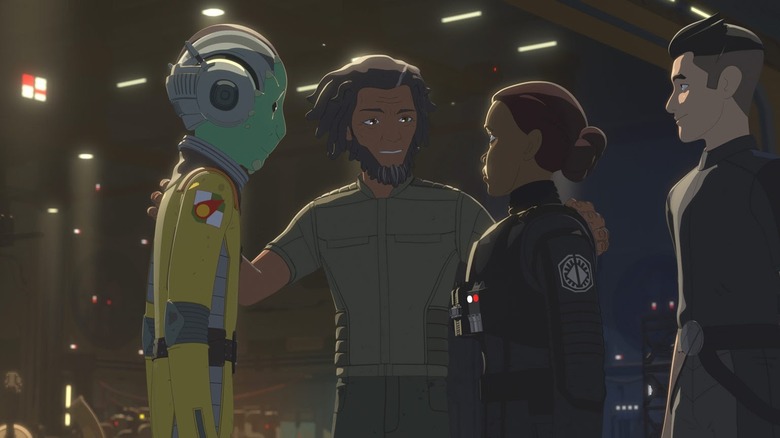
The final act in "Star Wars Resistance," which ended after Season 2, is a mundane one. Kaz and Yeager retrieve Tam Ryvora from the First Order and she's welcomed back. They celebrate by grabbing drinks in the Colossus' bar, which is messy after the scrappy and successful fight against the First Order's carrier. As the barmaid, Aunt Z, chirps, "That's the price of freedom!"
What's noteworthy is that there's no sense of conclusion. The residents of the Colossus feel joy, but an air of anxiety lingers. Yet, the fade to black is bold. They may have eradicated their main antagonists, but the audience knows that they're still wanted by the First Order, which will remain a threat until the end of "The Rise of Skywalker." Still, those final seconds at the Colossus' bar exemplify how the survivors can win the battle: by resuming communal activities, recalling the days before the war. It's the present moment that counts.
The Clones' Gravesite — Star Wars: The Clone Wars
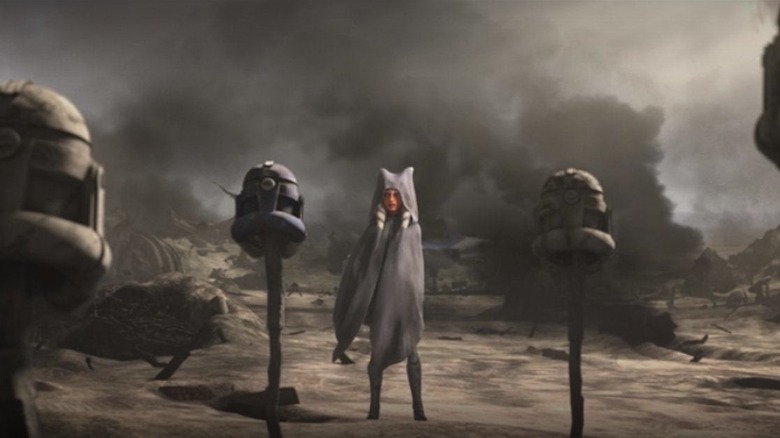
The last "Clone Wars" episode is a bone-chilling epitaph for a bygone era. The final five minutes of "The Clone Wars" end the series on a mass grave of clone soldiers, their helmets marking each burial mound. The imagery exemplifies what the war amounted to: an ever-growing problem that opened the door to an evil regime and extorted unfortunate soldiers who were bred for a single, meager purpose.
The more we linger at the gravesite, the thicker the ambivalence becomes. The ending of "The Clone Wars" shows a soot-cloaked Ahsoka while a hazy light shines over the tombs, contradicting to her future appearances, in which she wears a pure-white cloak. The blemishes on Ahsoka's cloak show how the war has stained her -- she suspects that her choices have cost her brothers' lives, thanks to the ship collision and her inability to save them all.
When Darth Vader investigates the wreckage a little later, we're also excavating the pieces. When he gazes at the owl-like Convor, it signifies Ahsoka, who has moved beyond him. When Vader turns back, his silhouette catches the visor of a clone soldier's helmet. Silent and symbolic, the moment memorializes the clones' expendability and the emptiness of the war they fought, closing out an era.
The Clones' Execution Of A Fallen Jedi — Star Wars: The Clone Wars
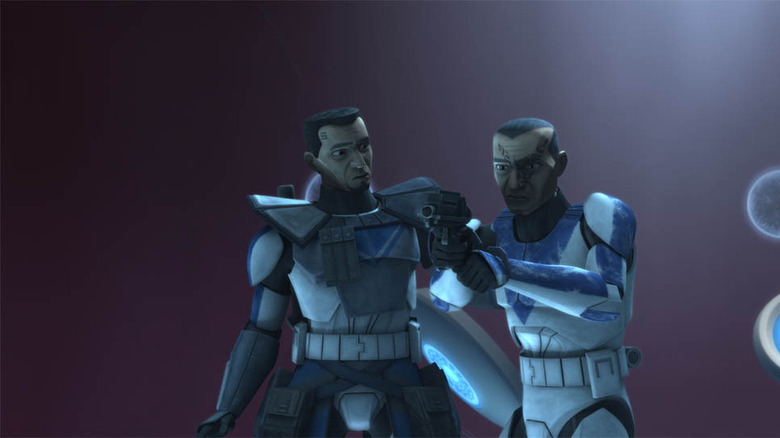
The Umbara arc in "The Clone Wars" is notorious for good reason: it highlights a worst-case scenario for Captain Rex and his clone soldiers. In this arc, the clones are under the command of a brutal and cold Jedi general named Krell who cares nothing for their welfare. He justifies his austerity as pragmatism, making the clones second-guess their orders and bolstering their skepticism of their leader. Throughout the storyline, Rex and others circumvent Krell's orders to get results. But Krell crosses an unspeakable line: He deceives the clones and tricks them into shooting each other on the battlefield. Shocked, the soldiers conclude that they must commit treason to bring justice to their fallen brothers. Even with all their training, they're not prepared to follow this path.
Preceded by an enthralling sequence in which a bevy of clones ambush the four-armed Force-wielder, the final five minutes of the Umbara arc reaches a spectacular psychological conclusion. Rex tasks himself with executing Krell, but can't pull the trigger. What's stopping him? Conditioned loyalty to the Jedi? Fear that he's committing treason? Then Dogma, the clone once most loyal to Krell, finishes the job for him. You would expect Dogma to accept that his actions were justified by the situation, but instead, he rationalizes what happened in front of his brothers, as if he still isn't sure that he did the right thing.
Anakin's Cave Hallucination — Star Wars: Clone Wars
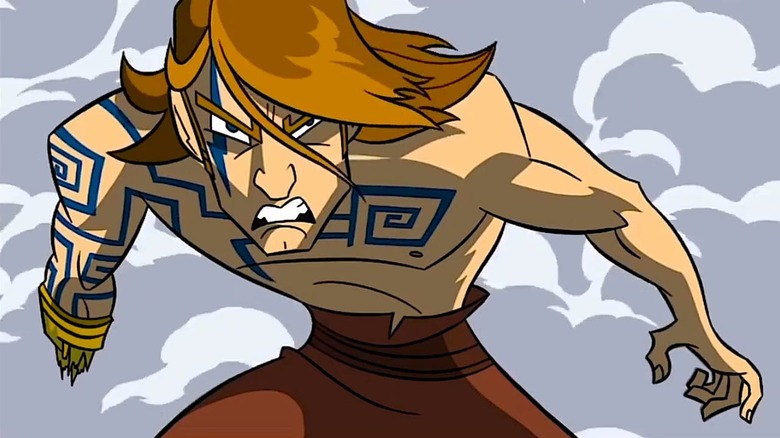
Jedi have cave visions. Luke saw himself in Vader's helmet in "The Empire Strikes Back." Rey saw herself as a Sith in "The Rise of Skywalker." In the 2003 "Clone Wars" micro-series, Anakin stumbles upon his cave moment during a retrieval mission. A deluge of cave paintings spins Anakin into a frenzy, giving him a hallucination that dances on the cavernous walls.
Falling into an extended, dialogue-free sequence that recalls other Tartakovsky projects like "Samurai Jack" and "Primal," the animator uses Star Wars lore and symbolic storytelling to foreshadow the impending tragedy -- this short was released one month before "Revenge of the Sith." The cave paintings come to life, telling surreal a folktale about a warrior. When the man loses his hand in battle, his beloved weaves him a new one, mirroring Anakin's Jedi career and his love for Padme. With his new hand, the warrior performs feats of derring-do and slays his enemies. However, when the villagers are celebrating, his artificial hand metamorphoses into fanged branches. The darkness in his hand metastasizes, swallows villagers, and sweeps away his beloved. Then, the lines shift and reassemble into the shape of Vader's helmet. The vision ends with Padme's voice screaming for Anakin.
After the release of "Revenge of the Sith," the CGI "The Clone Wars" restaged Anakin's nightmarish vision, but reused too much imagery from the movies. Its CGI feels more "real," but it's diluted in texture, and does not resonate as much as the moving cave paintings.
Read this next: Every Episode Of Star Wars: Visions Ranked From Worst To Best
The post The 13 Best Animated Star Wars Moments appeared first on /Film.
from /Film https://ift.tt/3zwpjOX
No comments: